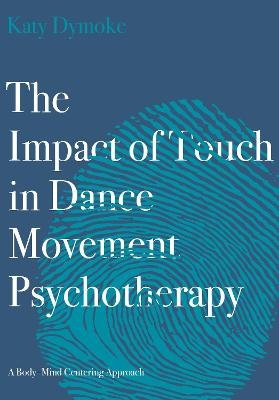
The Impact of Touch in Dance Movement Psychotherapy
Intellect Books (Verlag)
978-1-78938-459-8 (ISBN)
This book explores the therapeutic use of touch, focusing on an in-depth case study of work in an NHS setting with a client with learning disabilities, and situating this within a wide theoretical context. This is a unique and influential study illustrating the impact of touch in dance movement psychotherapy and laying the ground for a theory on the use of touch in Dance Movement Psychotherapy (DMP).
The case study illustrates the impact of touch upon the therapeutic relationship with the use of video transcription and descriptive reflexive accounts of the session content. The case analysis sections establish the ground for a paradigm shift, and for emergent theory and methods in support of the use of touch in Dance Movement Psychotherapy and other contexts. The role touch takes is beyond its affect, which expands our understanding of its potency as an intervention. The writing is embedded in many years of practice-led-research in the field of dance and somatic practices, in particular Body-Mind Centering® and Contact Improvisation, in which touching and being touched is met with curiosity as a place of insight and revelation, beyond the bounds of taboo and social diktat.
The study considers the philosophical landscape of both touch and non-touch. This book explores and reflects upon the use of touch, considering the wider context and socially imposed perceptions that would prevent touch from taking place – including philosophical and social discourses. Through telling the story of a client case, the book offers a wealth of thought-provoking content to inspire continued dialogue.
Key strengths of this book are the depth, warmth and perceptiveness of the case history, and the way in which this is successfully linked with theory. Particular attention is paid to embodied cognition and exosystemic theory, the two leading developments of current thinking.
With the ethical, practical and philosophical content, the book will be of interest to psychotherapists, health and social care practitioners, as well as arts in health practitioners and beneficiaries in educational programs and settings.
Primary readership will be among DMP psychotherapists, body psychotherapists, drama therapists, Body Mind Centering® practitioners, arts in health practitioners, people working with clients with learning disabilities and any practitioner and researcher interested in understanding the role touch may play in the psychotherapeutic encounter.
Body–Mind Centering programme director and Dance Movement psychotherapist, Katy Dymoke works with children, adults and all abilities in a reciprocal experiential process. In writing about her practice, Katy seeks to support others to examine and grow as practitioners.
List of figures
Preface and chapter summary
Acknowledgements
Abbreviations
Chapter 1. Introduction
1.1 Background: Touch a natural language
1.2 A 'touch revolution' in a dance–sport called contact improvisation
1.3 The sensory and sexual differentiation of touch, co-operation and responsibility
1.4 Touch - a way of 'seeing' or a mutual place of being?
1.5 The psychotherapist becomes researcher
Chapter 2. The personal and professional quests 2.1 The sensory acuity of touch – contemplating a pathway of change
2.2 Literature on touch; the absent body - the 'touch or no-touch' debate
2.3 The pro-touch discourse explored and explained
2.4 Relational aspects; the subjectivities of 'touching subject' - 'touched object'
2.5 Theories of consciousness
2.6 The matter of the psyche; or what matter is the psyche? Summary
Chapter 3. The research design – defining roles
3.1. A qualitative framework and mixed method approach
3.2. Defining the selves: The multiple subjectivities
3.3. Data analysis – methods and implementation
Chapter 4. Embodied Ethics
4.1. Earning legitimacy and ethical approval
4.2. Towards an embodied ethics; a phenomenological insight
4.3. The Research Governance Framework, an intransigent construct
4.4. The ethical demise of embodied ethics
4.5. The Integrated Research Application System (IRAS)
Chapter 5. CASE STUDY SESSION 1: Transcript and data analysis
'You child angry heart?'
Amanda as participant; managing autonomy.
Chapter 6. CASE STUDY SESSION 4: Transcript and data analysis
Establishing a mutual language; beyond good and bad touch
Towards introspection, an intrapersonal and transpersonal approach
Tying in the thread of integrative approaches to Dance Movement Psychotherapy
Chapter 7. CASE STUDY SESSION 6: Transcript and data analysis
Chapter 8. FINDING AN ENDING AND EMERGENT THEORY
Chapter 9. TOWARDS A THEORY OF RECEPTIVITY; Touching once again upon touch
Arriving at receptivity – an 'ethic of care' (Etherington 2007: 604).
The pre-ontological space and time domain of the body
Appendix 1. Embodied Ethics continued
Part 1. The co-researcher role and the ethics of inclusive research-seduction or sensitivity, occlusion or collusion; a question of 'capacity'?
Part 2. Ethical issues in mixed methodological research
Part 3. Hope at Hand – the ethics of research and the ethics of treatment
Summary
Appendix 2. For Chapter 5, diagrams 1-4 and 5. (i) and (ii)
Appendix 3. For Chapter 6. Prehension theory diagram,
Appendix 4. For Chapter 8. Client competence, session 1 and 10
Appendix 5. Martz and Lindy, The trauma Membrane Concept (2010)
Appendix 6. Perceptual-Response Cycle
| Erscheinungsdatum | 07.07.2021 |
|---|---|
| Zusatzinfo | 16 Diagrams |
| Sprache | englisch |
| Maße | 170 x 244 mm |
| Gewicht | 503 g |
| Themenwelt | Sachbuch/Ratgeber ► Gesundheit / Leben / Psychologie |
| Sachbuch/Ratgeber ► Sport ► Tanzen / Tanzsport | |
| Medizin / Pharmazie ► Medizinische Fachgebiete ► Psychiatrie / Psychotherapie | |
| ISBN-10 | 1-78938-459-1 / 1789384591 |
| ISBN-13 | 978-1-78938-459-8 / 9781789384598 |
| Zustand | Neuware |
| Haben Sie eine Frage zum Produkt? |
aus dem Bereich


